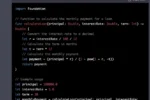On October 5, 2024, a strong earthquake shook Iran, and soon after, wild rumors began to spread online claiming it was a secret nuclear test! But scientists from Johns Hopkins University investigated and found that the earthquake was completely natural. In this fascinating story, we’ll explore what really happened during that day, how the scientists used special tools to study the earthquake, and why it’s important to know the truth in a world where misinformation can spread like wildfire. Let’s dive into the science behind earthquakes and the power of accurate information!
| Attribute | Details |
|---|---|
| Event | Magnitude 4.5 earthquake in Iran on October 5, 2024 |
| Location | 31 miles southwest of Semnan; 135 miles east of Tehran |
| Initial Rumor | Rumors claimed it was a nuclear weapons test |
| Research Findings | Study by Johns Hopkins University confirmed it was a normal seismic event |
| Seismic Analysis | Earthquake caused by a reverse fault due to tectonic plate collision |
| Misinformation Spread | First post on social media appeared 20 minutes after the quake |
| Media Coverage | Global media speculated on nuclear test; Persian media reported accurately |
| Potential Consequences | Misinformation could escalate geopolitical tensions |
| Recommendations | Scientific agencies should issue reports quickly to combat misinformation |
Understanding Earthquakes and Their Causes
Earthquakes happen when the Earth’s tectonic plates move and cause the ground to shake. In Iran, a recent earthquake measured 4.5 on the Richter scale. Scientists believe this quake resulted from a reverse fault, which occurs when two plates push against each other. This natural process is common in regions like Iran, where tectonic plates collide, making earthquakes a regular occurrence.
When earthquakes occur, they can sometimes lead to confusion and fear. For example, after the quake in October 2024, some people mistakenly thought it might be a nuclear test. Scientists quickly worked to analyze the event, using data from seismic stations to confirm that it was indeed a natural earthquake. Understanding how earthquakes work helps us recognize that not every shaking ground is caused by something man-made.
The Impact of Misinformation on Public Perception
Misinformation can spread rapidly, especially on social media. After the October earthquake in Iran, rumors circulated that it was caused by a nuclear test. This kind of false information can create panic and confusion among people. Researchers found that within minutes of the earthquake, posts on social media began to blame other countries and suggest that the quake was not natural at all.
The danger of misinformation is that it can influence how people view events and situations. In the case of the earthquake, inaccurate reports made it harder for the public to understand what actually happened. Scientists and media outlets have a responsibility to provide clear and accurate information to prevent misunderstandings and to help people stay informed about real events.
The Role of Scientists in Combating Misinformation
Scientists play an important role in ensuring accurate information is shared with the public. After the earthquake in Iran, researchers from Johns Hopkins University quickly analyzed the data to confirm the cause of the quake. Their work highlighted the need for scientists to respond quickly to rumors and misinformation. By explaining the science behind earthquakes, they can help clear up confusion.
Additionally, scientists can collaborate with social media platforms to help spread accurate information. By providing clear reports and explanations, they can counter false claims before they spread too widely. It’s essential for researchers to communicate effectively so that the public understands the truth and can distinguish between real science and misleading information.
Understanding Seismic Activity in Iran
Iran’s geographical position makes it a hotspot for seismic activity, primarily due to the convergence of the Arabian and Eurasian tectonic plates. Here, tectonic forces create significant pressure that can lead to earthquakes, such as the recent 4.5 magnitude quake on October 5, 2024. The region has a long history of seismic events, underscoring the importance of understanding geological processes to differentiate between natural occurrences and potential man-made activities.
Such seismic knowledge is crucial, especially in a politically charged environment where allegations of nuclear tests can escalate tensions. By comprehensively studying seismic data, scientists can better inform the public and policymakers about the true nature of earthquakes, dispelling myths and preventing misinformation from spreading. This understanding is vital in mitigating fear and ensuring that communities are prepared for natural disasters.
The Role of Social Media in Spreading Misinformation
In our digital age, social media serves as a primary source of information, but it can also be a breeding ground for misinformation. Following the October earthquake in Iran, social media platforms saw a surge of unfounded claims suggesting the tremor was a nuclear test. The rapid dissemination of such misinformation underscores the responsibility of social media platforms to manage content and provide accurate information, particularly during crises.
Moreover, the initial posts about the earthquake’s cause appeared just minutes after the event, highlighting how quickly misinformation can take root. This phenomenon emphasizes the need for users to critically evaluate the sources of their information and for platforms to implement strategies that prioritize verified accounts and scientific expertise. Enhancing media literacy among the public can also play a crucial role in curbing the spread of false narratives.
The Impact of Media Coverage on Public Perception
Media coverage plays a significant role in shaping public perception, particularly during events like natural disasters. In the case of the 2024 earthquake in Iran, many mainstream media outlets speculated about the possibility of a nuclear test without sufficient verification. Such reporting can inadvertently lend credibility to false narratives, leading to widespread public concern and confusion regarding the situation.
Conversely, local Persian-language media provided more accurate reports by consulting regional experts and focusing on factual information. This disparity highlights the importance of responsible journalism and the need for media outlets to prioritize accuracy over sensationalism. By promoting thorough investigation and expert opinion, the media can contribute to a well-informed public and reduce fear and misinformation surrounding geopolitical crises.
Strategies to Combat Scientific Misinformation
In light of the widespread misinformation surrounding the October 2024 earthquake, scientists have proposed several strategies to combat similar issues in the future. One suggestion is for scientific organizations to issue timely and detailed reports that clarify the nature of seismic events and dispel rumors promptly. Such proactive communication can help prevent the spread of misinformation and reassure the public about the realities of natural disasters.
Additionally, partnerships between social media platforms and reputable scientific agencies, such as the U.S. Geological Survey, could enhance the visibility of accurate scientific information. By amplifying messages from verified sources, these platforms can play a crucial role in countering misleading narratives and ensuring that the public receives reliable information during crises. This collaborative approach could be instrumental in protecting the integrity of scientific discourse.
Frequently Asked Questions
What caused the earthquake in Iran on October 5, 2024?
The earthquake was caused by a **reverse fault**, which happens when the Earth’s crust is pushed together. This is typical in areas where tectonic plates, like the **Arabian** and **Eurasian** plates, collide.
Why did some people think the earthquake was a nuclear test?
After the earthquake, rumors quickly spread on social media claiming it was a **nuclear weapons test**. These ideas were based on misunderstandings and were not supported by scientific evidence.
How do scientists study earthquakes?
Scientists called **seismologists** study earthquakes by recording **seismic waves** from different locations. This helps them understand what caused the earthquake and its effects.
What is misinformation and why is it dangerous?
**Misinformation** is incorrect information that spreads quickly, especially on social media. It can create confusion and lead to **serious consequences**, especially during political tensions.
How can scientists help stop the spread of false information?
Scientists can issue **detailed reports** quickly to clarify facts. Partnering with social media platforms can also help share accurate information and reduce misleading stories.
What is the role of the Comprehensive Test Ban Treaty Organization (CTBTO)?
The **CTBTO** monitors and verifies nuclear tests worldwide. It confirmed that the earthquake in Iran was not a nuclear test, helping to clear up confusion.
Why is it important to verify information about events like earthquakes?
Verifying information is crucial because it helps prevent panic and misunderstandings. Accurate news can help keep people safe and informed during crises.
Summary
The content discusses the October 5, 2024, earthquake in Iran, which was incorrectly rumored to be a nuclear weapons test. Researchers from Johns Hopkins University have debunked these claims, confirming it was a natural seismic event caused by tectonic plate movements. The study emphasizes the role of misinformation during geopolitical tensions, as false narratives spread rapidly on social media. While global media often speculated about a nuclear test, local Persian-language outlets reported more accurately. The researchers suggest that scientific agencies should act quickly to counter misinformation to prevent potential global consequences.







